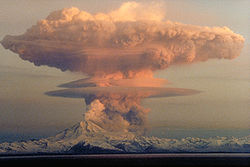http://iopscience.iop.org/article/10.3847/1538-3881/aa991f/meta
Archives
All posts for the month May, 2018
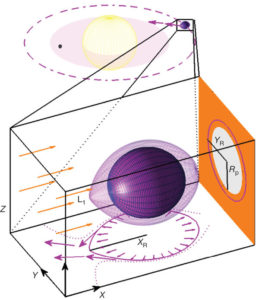
(top) WASP-12 b’s orbit. (bottom) The Roche lobe around WASP-12 b.
WASP-12 b is a planet in crisis.
One of the hottest of the hot Jupiters, the gas giant circles its Sun-like host star in a blistering 1.09-day orbit, giving its an atmosphere hot enough to vaporize rubies.
In fact, WASP-12 b is so close to its star that it very nearly fills its Roche lobe, the teardrop-shaped region inside of which material is bound to the planet. Anything on the other side of the Roche lobe falls into the gravitational clutches of the host star and can either tumble into the star or leave the system altogether.
Because WASP-12 b’s atmosphere is so hot, it is very puffy and extended, and a study from several years ago pointed out that some of the atmosphere can probably spill over the Roche lobe and escape the planet. Indeed, several groups have seen indications of outflow from WASP-12 b, meaning the planet is falling apart in front of our eyes.
Knowing what happens to the gas after escaping the planet is important for understanding the fate of the planet. If the gas goes into orbit around the star, forming an accretion disk, the planet might have billions of years before it’s destroyed. On the other hand, if the gas quickly escapes from the system or is otherwise prevented from forming a disk, the star’s gravity could rip the planet apart in an astronomical blink-of-an-eye.
A recent study from Alex Debrecht and colleagues from University of Rochester Physics and Astronomy explored what happens to gas escaping WASP-12 b. For their study, they constructed hydrodynamic models using the AstroBEAR code and found that a substantial torus of hot gas could build up around the host star in about a decade, potentially enough gas to explain the observations showing some kind of spectral absorption from the system. Such tori may commonly form in systems with ultra-hot Jupiters, so this study is probably relevant to lots of exotic exoplanets.
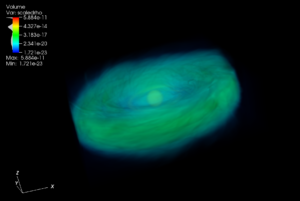
Three-dimensional simulation of gas torus in the WASP-12 system.
As interesting as these results are, though, they leave some important issues unaddressed. For instance, Debrecht and colleagues didn’t seem to include any accretion onto the host star, which might happen proceed at a fairly high rate. And the balance between outflow from the planet and accretion onto the star will go a long way to determining the amount of material in the accretion disk.
And knowing the amount of material in the disk on orbits interior and exterior to the planet’s orbit is critical for understanding the fate of WASP-12 b and other similar ultra-hot Jupiters. The accretion disk can gravitationally tug on the planet – material interior can push the planet out, while material exterior can push the planet in, potentially dooming the planet to rapid disruption.
But as is true for even the most seminal scientific work, more research is needed.
There are currently only about half a dozen Earth-sized planets orbiting stars that you can see without a telescope or binoculars, called “naked eye stars“. Among this select class, the 55 Cancri system stands out as unique – located in the constellation Cancer, 55 Cancri, a star very similar to our Sun, hosts five planets, ranging from Earth-sized to bigger than Jupiter.
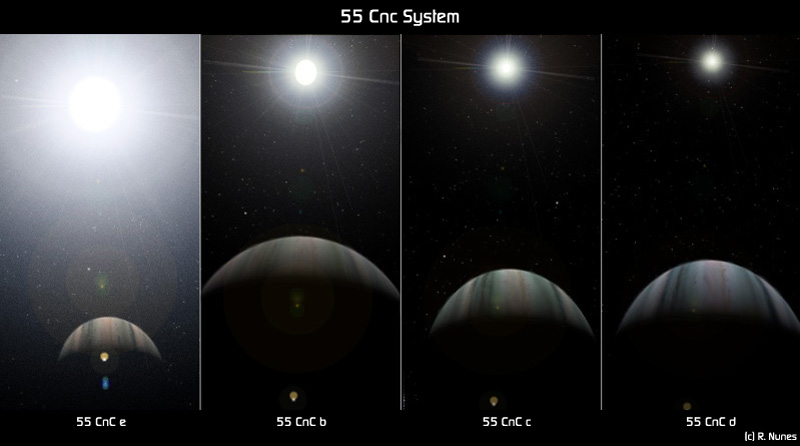
Artist’s conception of the views from four of the 55 Cancri planets. From https://en.wikipedia.org/wiki/File:55cnc.jpg.
The innermost planet, 55 Cancri e, is the one most similar to our own planet, with a mass eight times Earth’s and radius twice Earth’s.
In some big ways, though, 55 e is a far cry from Earth – it’s almost a hundred times closer to its star than we are to ours, meaning its year is only about 18 hours long. Recent observations from the Hubble Space Telescope also suggest it has a hydrogen and helium atmosphere with a pressure comparable to Earth’s. But one thing 55 e might have in common with Earth: active volcanoes.
A recent study from Patrick Tamburo of Boston University analyzed infrared observations of the 55 Cancri system collected by the Spitzer Space Telescope and found evidence for some sort of dramatic change on 55 e.
The observations were collected just as 55 e plunged behind the star as seen from the Earth. Such a configuration is referred to as a planetary eclipse or occulation.
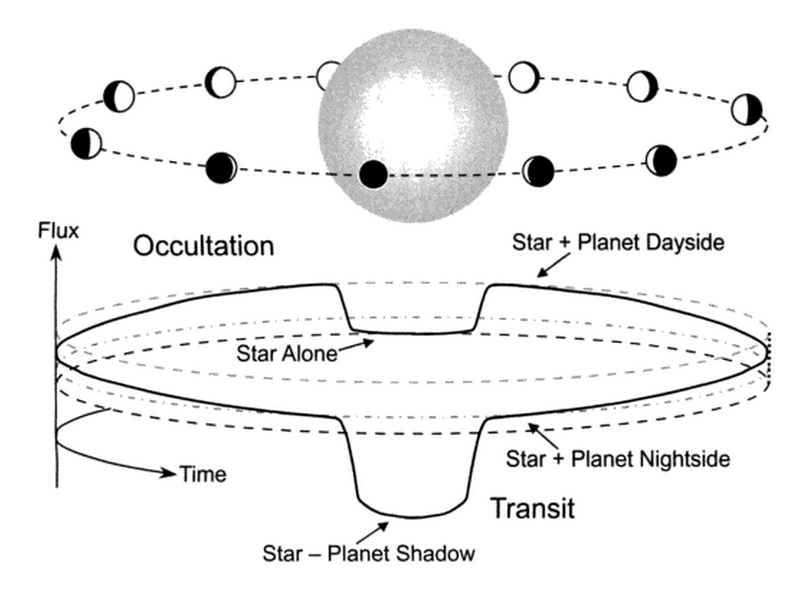
A comparison between transits and secondary eclipses (also sometimes called occultations). In a planetary transit, the planet crosses in front of the star (see lower dip) blocking a fraction of the star’s brightness. In a secondary eclipse, the planet crosses behind the star, blocking the planet’s brightness (see dip in the middle). The latter dip in brightness is fainter due to the faintness of the planet. Image credit: Josh Winn.
During an eclipse, the planet’s host star blocks out any light coming from the planet, which can produce a tiny dip in the total amount of light coming from the system.
The depth of that eclipse dip tells us how bright the dayside of the planet is – a very bright dayside would produce a big dip, indicating a hot and bright atmosphere, while a dark dayside would produce no dip, meaning a very cool atmosphere. But what if the dip is shallow during some eclipses and deep during others?
That’s exactly what Tamburo and colleagues found. In 2012, the planet exhibited eclipses with little to no depth. But when Spitzer revisited the system in 2013, it found whopping eclipses, with the planet emitting about 0.02% of the star’s light. This change corresponds to an increase in the planet’s apparent temperature of more than 1,000 degrees Kelvin (about 2,000 F).
What could cause such a dramatic change? As in the original study of these data, Tamburo and colleagues explore the possibility that an enormous volcanic eruption on 55 e could have injected dust high into the atmosphere (about 100 km up) in 2012, shrouding the lower and hotter atmosphere and surface. By 2013, the dust cloud could have settled out, raising the planet’s apparent temperature.
How plausible is this idea? Surprisingly, plausible actually. Previous studies of 55 e have shown that interactions between the planet and its sibling planets could induce enormous amounts of tidal heating within 55 e, similar to Jupiter’s moon Io, and potentially powering tremendous geophysical activity.
Large terrestrial eruptive plumes have reached 40 km height in Earth’s atmosphere, so perhaps such altitudes are not unreasonable on 55 e. However, 55 e has a surface gravity more than twice Earth’s and its atmospheric temperatures are likely much higher than Earth’s, both of which would inhibit ascent of a volcanic plume. So it’s not totally clear this exciting idea could pan out in detail.
In any case, these new results may represent the emergence a new field of study, observational exoplanetary volcanology, and maybe scientists a few generations from now will be trying to predict volcanic activity on Kilauea and Cancer.
